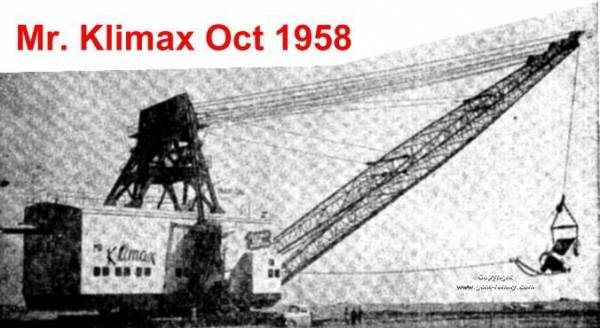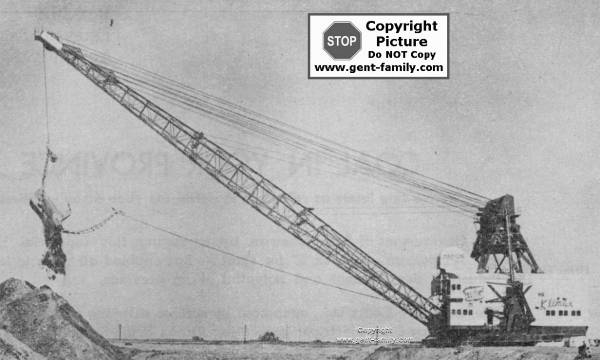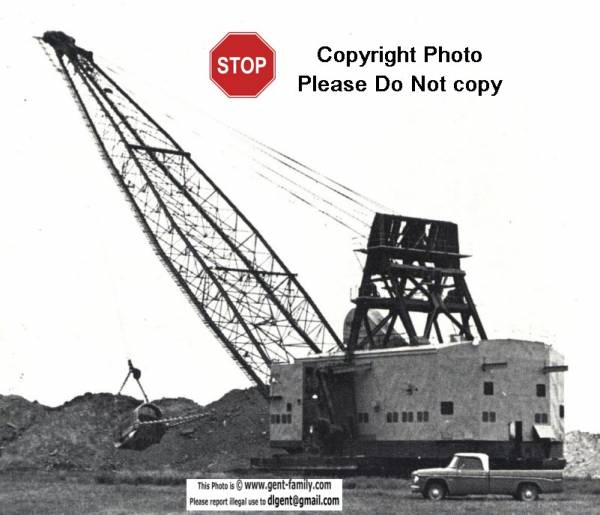
Marion 7800 Dragline
Estevan, and Taylorton, Saskatchewan, Canada
Mr Klimax Located at Western Dominion Mines
“Mr. Klimax” was really a Marion M7800 dragline, built 1957- 1958, south of Bienfait Saskatchewan Canada, at the Western Dominion Mine.
First used at the Western Dominion Collieries, whose coal brand at that time was “Klimax” Coal
Owned by the Great West Coal Company Limited, which was owned by John Robert Brodie, based in Brandon MB..
It was purchased through Huggard Equipment, 1421 Whyte Ave. in Winnipeg MB. They were in business as early as 1948.
Became Champion Road Machinery Equipment Sales, part of the Champion Group of companies of Goderich, ON.
Huggard was Champion's oldest Dealer in Canada. They sold Champion Graders in 1946.
For years I thought it was built south of Estevan, in 1958, but now I know this is not true.
It was moved, and used at the Utility Coal Mine later, then in 1970, moved to the Boundary Mine.
Original cost estimate= $2,000,000 in 1956 $'s
It had a 220 foot boom originally, but after rebuilding in 1970, the boom was extended by 20 feet.
This added 25 tons extra to the original weight.
In it's day it was a very impressive machine, and the talk of the District.
Everyone knew about “Mr. Klimax”!
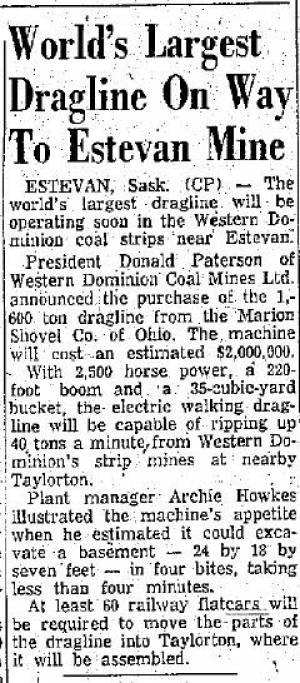 “Mr. Klimax” Dragline ordered from the Marion Power Shovel Company,
“Mr. Klimax” Dragline ordered from the Marion Power Shovel Company,
from Marion, Ohio, USA. Sept 17, 1956
President Donald Paterson
Plant Manager, Archie Hawkes.
 Oct 25, 1958,
Big Bertha nickname for Mr Klimax
Oct 25, 1958,
Big Bertha nickname for Mr Klimax
For years I thought this dragline was built near Utility Coals, and a special rail line was laid in there for it, so if it wasn't Mr. Klimax, which one was it?
Maybe it was near Bienfait where I lived until 1958.
I do remember seeing this railway line though. Well now I know my memory is shot.
Just to verify the article I found above, this email came in to me, from Mr. Bob Just.
Here is what he sent to me Nov 26th, 2008.
“I was reading your article on Taylorton & Mr Klimax.
I noticed you thought it was built at Boundary Dam, in fact it was built at Western Dominion Mine in 1958, and my Dad Fred Just was the First Operator.
He then moved it to the new Manalta mine, Est of Estevan in the early 60's.
Then he also moved it over to Boundary Dam, where it was turned over to Utility Coal Operators.
I lived at Taylorton until 1947 when we moved to Estevan.
One of the pictures you show of Mr. Klimax has my Dad's 68 Dodge Pickup beside it, so the picture was still taken at Manalta.
I have a picture which hung in the Corporate Office of my Dad and a Company pickup in the bucket, taken by Jack Jenish”
Now we know the real history of this machine, Thanks Bob for sending this correction in.
Original specs of the Marion 7800
Weight- 3,205,000 lbs / 1,600 tons
Height to top of cab= 34' 6“
Length of boom= 220' 0”
Height of Boom= 70 ft.
Capacity of bucket= 35 Cubic yards
Bucket weight= 33 Tons
Dumping radius= 211' 0“
Electrically Operated- 2,500 total Horse Power
Took 48 Railway cars to ship from Marion, Ohio.
30,000 man hours to assemble it.
Walking Shoes: length= 48 ft. width= 9ft.
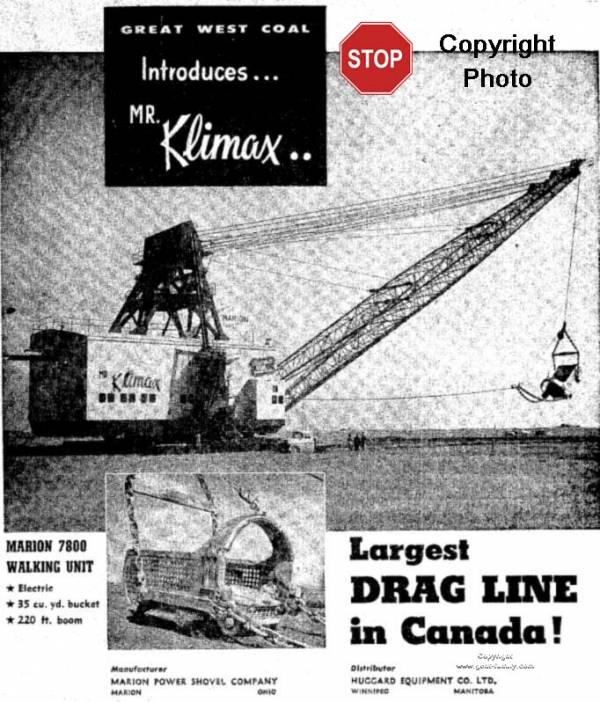 Mr. Klimax, Great West Coal Co. Ad,
Oct 25, 1958
Mr. Klimax, Great West Coal Co. Ad,
Oct 25, 1958
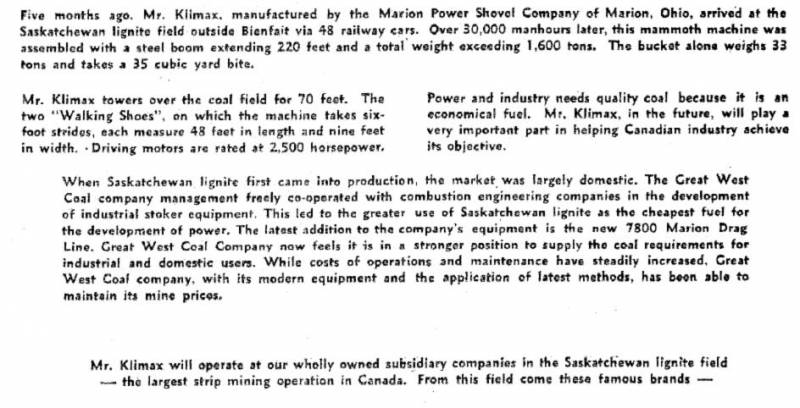 Mr. Klimax Article,
Oct 25, 1958
Mr. Klimax Article,
Oct 25, 1958
Interesting to note, the first picture on the next page is date stamped April 1958, and it clearly shows this machine working then.
So exactly when was it put into production?
If it took 5 months to build, it started in fall of 1957.
Why did they built it in the middle of a Saskatchewan winter?
Marjorie Turton tells me the original boom was shortened by 20 feet afterwards, due to too much strain on the dragline, for the overburden they were digging in.
I noticed a distinctive feature of this dragline is the round, tear drop shaped structure on the right, top, front of the House structure.
Marion name is painted on this to identify the maker.
After the rebuild, it was supposedly, no longer “Mr. Klimax”.
Here is the purpose for the tear drop structure:
Mr Aaron Honyara sent me this email from PA, USA
message = “Great pics, on the first page of the Mr. Klimax you asked what the tear drop structure was for.
If you carefully look where the drag cable enters the house it goes around the first wheel and goes up a tube
on the front and then inside the tear drop, it goes on a wheel that's inside that structure, then down to the drag drum.
Hopefully this info helps you”
Now I know, and you too!
If you look close in the 1958 picture above, the structure is there.
“Mr. Klimax” was originally painted on the sides of the House, behind the A frames.
It was at the time, in 1958, the Largest Walking Dragline in Canada, and for many years after.
Doing research on this machine, I found out other draglines had the walking feature before this model.
For years I thought it was the first, but that isn't true.
While at Utility, it was painted the Utility Coals colors, Dark yellow, (burnt Orange?) with reddish brown trim
I only found one color picture of this machine.
“Mr. Klimax” Marion 7800 Dragline, Working Pictures
In 1970 Mr. Klimax was refitted with a 20 ft longer boom, and 25 extra tons of weight.
But the biggest change it was no longer called Mr. Klimax
At Boundary Mine, Utility Coals Ltd, in 1970 they were using the 70 ton coal Haulers, which can carry an entire rail car load at a time. These were loaded with a 170B shovel, with a 10 cubic yd bucket, a 100B 5 cubic yd shovel, and a 120B 6 cubic yd shovel maintaining a stockpile of coal of approx 125,000 tons at the Boundary Dam plant
 ca 1943 Ad for the Marion 7800
ca 1943 Ad for the Marion 7800
from Nickolas S. Koba Jr.
Info from Nick-
I an enclosing an advertisement from about 1943 of Marion's new 7800 draglines, this is a photo of the first one built - Serial number 7509 it was built in 1941.
It is the same model as your Mr. Klimax,
If you are interested in the spec. sheet on these draglines let me know . Nick Koba
PS- the first 3 Marion 7800 went to the Northern Illinois Coal Corporation mine near Wilmington, Illinois.
there were 19– 7800 made, the last one in 1964
Thanks Nick!
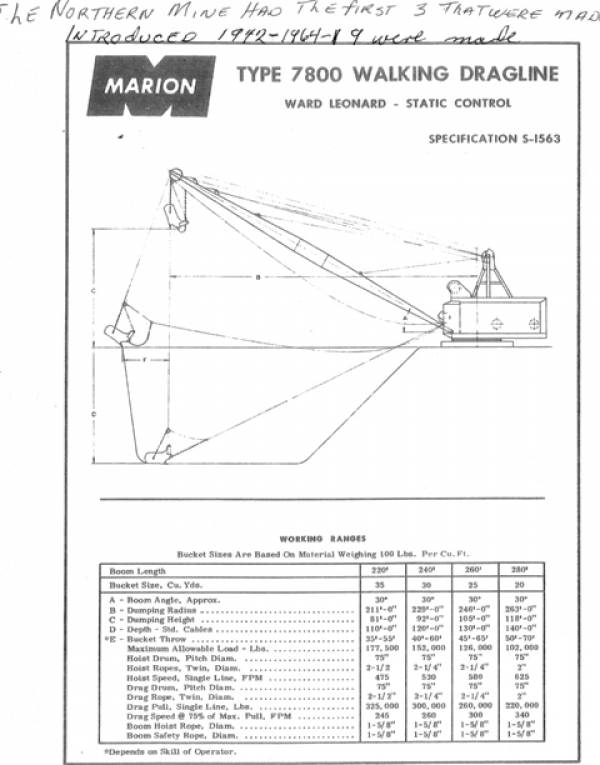
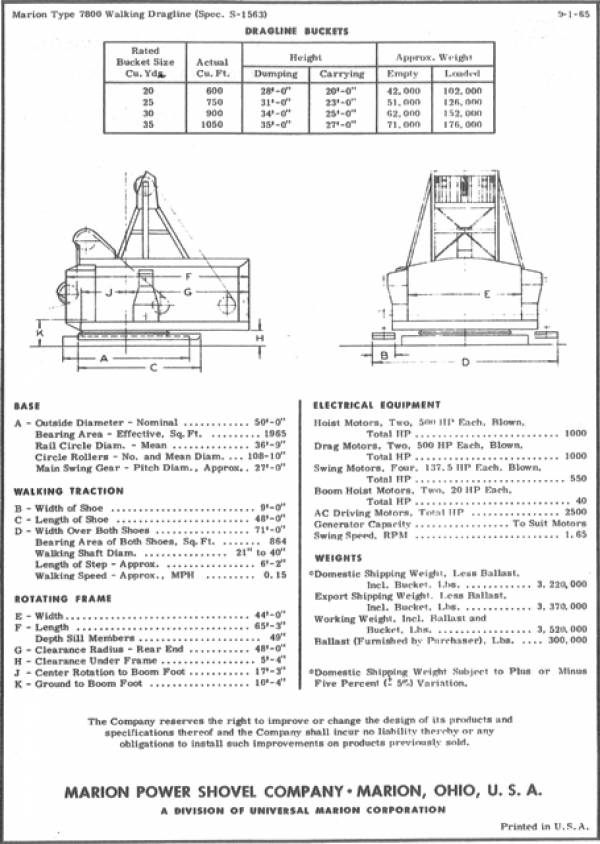
Marion 7800 Spec sheets
courtesy Mr. Nickolas S. “Nick” Koba Jr.
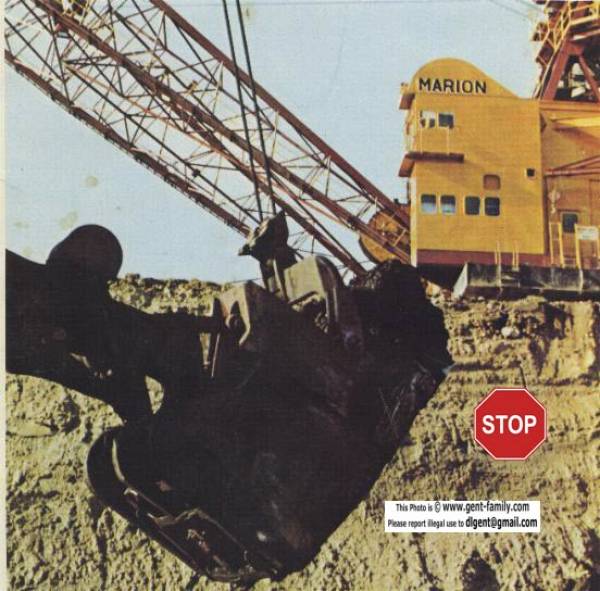 “Mr Klimax” Marion 7800, ca 1970
“Mr Klimax” Marion 7800, ca 1970
(Bucket from the Bucyrus-Erie 750B stripping shovel in front)
Marion was sold to Bucyrus in 1997, and they then sold again, in 2011, to “Caterpillar Global Mining”
©
